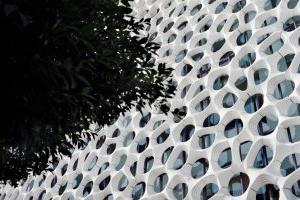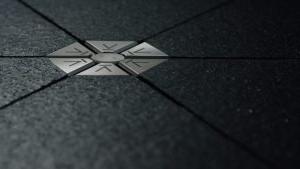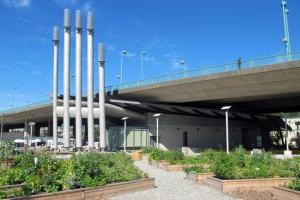创造更美好世界的五项清洁技术创新
On November 8, 而大多数人的目光都集中在美国, important news came out of COP22 in Marrakech: 2016 is on track to be the 有记录以来最热的一年. 美国大选的结果是 这不是一个有希望的步骤 在应对气候变化方面. 这种环境上的挫折受到了显著的反击 advances that cleantech innovators have made in recent years however. While many of these innovators are committed to creating a more sustainable world, 他们也认识到自己产品的市场潜力. There’s no disputing that addressing the existential threat that is climate change is daunting, 但这里有五项技术会有所帮助:

The facade at the Manuel Gea Gonzalez Hospital in Mexico City neutralizes harmful smog-causing chemicals. Image: 优雅的装饰
通过向建筑物喷洒二氧化钛处理, 外墙和屋顶可以成为烟雾中和剂. 当暴露在阳光下, 具有成本效益的处理反应 with nitrous oxides that result from fuel combustion and breaks these chemicals down into less hazardous compounds. 当这种疗法被应用到墨西哥城的一家医院时, the single building was found to mitigate air pollution created by 1000 cars. The positive impacts of the treatment can be further enhanced through a 准晶立面设计 这样可以使建筑表面积增加200%. The result? 空气更清新,建筑更美观.

Sunflare的太阳能“壁纸”. Image: Sunflare
Between 薄膜太阳能“壁纸” and 特斯拉的新太阳能屋顶, the days of heavy solar panels installed on top of standard roofs appear to be coming to an end. 薄膜太阳能电池重量轻, much less resource intensive to manufacture and can be attached to anything that two-sided tape can stick too. It’s also flexible, which means it can be used on curving surfaces too. Tesla’s solar roof eliminates the need for panels because it is the roof itself. It comes in multiple styles and is essentially indistinguishable from a normal roof. Currently, they operate at 98% efficiency of standard solar panels (with improvements in the works), have “quasi-infinite寿命更长,预计成本低于标准屋顶. Why would anyone choose the old, less durable, more expensive option?

特斯拉的Powerwall 2可以为一个两卧室的家庭供电24小时. Image: Tesla
特斯拉太阳能屋顶建立在之前的清洁技术创新之上, 就像一个储能电池, at the company. A major drawback of traditional renewable energy has been the difficulty in storing energy for when it’s really needed (typically not the middle of the day). Tesla’s first Powerwall battery pack demonstrated the potential for decentralized storage. 但这是释放 Powerwall 2, which has more than double the energy storage capacity at about half the installed cost per kW/h and is expected to be able to power a two bedroom house for 24 hours, 这可能会使世界各地家庭的电池组正常化.

Pavegen的V3瓷砖利用行走的力量(字面意思). Image: Pavegen
你脚下的泉水可以点亮你头顶上的灯. Pavegen floor tiles sink slightly when stepped on, spinning an energy storing flywheel as they do. The third generation of this innovation produces five continuous watts of power as someone walks across them. At this rate, the technology is far from capable of powering homes or buildings, 但可以用来为LED路灯供电. 考虑到它可以应用于人们行走的任何地方, achieving greater energy production per step could be game-changing.

温哥华奥运村的区域供暖. Image: 温哥华市
These are 不是什么新技术但它们正在扩散,效率也在提高. 完善的系统,比如 Copenhagen, 为家庭节省大约1美元,400€ a year, 同时消除了大约665的创造,每年排放2000吨二氧化碳. 随着气温上升(有记录以来最热的一年),记住?), district cooling will also become important in reducing energy consumption. 斯德哥尔摩最新的区域冷却系统 serves about 70,000 people and can reduce energy consumption by a total of 45 GWH per year, 节省大约5美元,阻止1000吨二氧化碳进入大气层. 最重要的是, systems 它在一些城市流行起来 没有长期的传统 使用区域供热或制冷的.
这些创新是否意味着气候变化问题得到了解决? 不可能. 但随着不断的创新和持续的承诺 健康的流动 (除此之外), we can reduce the impact of climate change while making life a little better for all of us.







